Blog Archives
October 27, 2002 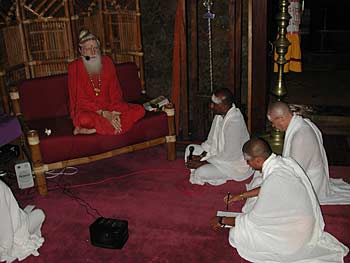
Gurudeva gives and inspired talk from his seat in the south east corner of the temple. Sadhaka Thondunatha translates into Tamil, Sadhaka Jothinatha into French, and Sadhaka Mahadevan (now Yogi Mahadevan) into Malay.
~~~~~~~~~~
Last day of the Phase:
We enter a two day retreat and this TAKA will remain up until Wednesday evening, October 30th.
Our Beloved and Revered Satguru Sivaya Subramuniyaswami
Attained Maha Samadhi on November 12th, 2001
Click to read for Details.
Mystic Mouse Coloring Book Now available
Today's sample page. ----- Click here to get your copy today!

Early this morning at about 6 AM, Bodhinatha gave a live talk interview with Pabitra Chowdhury of RBC Radio in New York. Mr. Chowdhury has been an avid reader of Hinduism Today and initiated these interview originally with Gurudeva. The station broadcasts to nearly 100,000 in the tri-state area and Mr. Chowdhury helps to host the religious programming that is run every Sunday morning. The subject of today's interview was "The Saivite View of Worship." Bodhinatha stressed some daily practice in the home, however short and the importance of teaching the children at a very early age, as, after age 12, it becomes more difficult to pass on the spirit of worship. Arumugaswami dropped in to briefly share with the audience the news of our on-line, e-mail news service, Hindu Press International.
No Audio Today
|
Be surprised! Take this opportunity for an adventure. Close your eyes and click to get a message picked at random from the vast audio archives of our Satgurus' discourses |
And click here for an Index to All Past CyberTalks.
|
 |
|
|
|
Live Web Cam Pix! |
 |
||||
In the publications office the pressure is on to finish the Mahasamadhi Souvenir and the "movie" comprising three hours of video clips of Gurudeva's teachings and travels. Our task forcer Shailesh has experience in Photoshop and we called on his skills to help process the over 300 images that are going into the printed souvenir. Each image has to be opened, cropped, color corrected and then mounted in the page layout program.
Yogi Japendra works on the same project while Sannyasin Natarajnathaswami in the back is focused on color correction of all the photos for the next issue of Hinduism Today.
Paramacharya Palaniswami performs his strategic duty as Editor-in-chief for Hinduism Today: reading and marking up final corrections on the copy.
Meanwhile, it was tour day and we had a visit from the congregation of the Lihue Hongwonji Buddhist Church. Nearly 100 people of all ages came to the monastery on this Sunday morning. The children of the church are being taught some religious values this Halloween by giving something to each house they visit, instead of the usual begging for candy. We found this brief description of the Hongwanji tradition on the web:
Shin Buddhism is a mainstream Mahayana school and was founded by Shinran (1173-1263). The Hongwanji developed from a temple built at the site of Shinran's mausoleum. For Shin Buddhists, the true nature of things is a lively wisdom and compassion that resonates in the lives of ordinary people. This wisdom and compassion takes form as Amida Buddha, meaning, 'Immeasurable Light Buddha' and 'Immeasurable Life Buddha'.
Taking pictures of the capstone of Iraivan which lies in storage awaiting the day when it will take its final resting place at the very top of the temple.
The building inspector for the county is a Buddhist and his wife Karen is very active in their Church. It was Karen's inspiration to invite the congregation to come to the monastery to see the temple and to pay homage at the Bo Tree that has been planted on San Marga.
A happy joyful group!
Up above, the center of the Parampara Stone is carved with an image of Lord Nataraja, Dancing Siva
Next the group goes off to walk over across San Marga, picking up rudraksha seeds on the way.
Yogi Mahadevan, our host.... this was his first really huge crowd and it was a new, challenging experience for him to guide such a large group and answer all of their thoughtful questions. Of course, Yogi did a great job.
Coming to the Bo tree.
The sacred Bo Tree (also called a peeple Tree and a Bodhi Tree) is a Ficus religiosa, like the tree the Buddha was enlightened beneath over 2,500 years ago. In fact, this tree is a direct descendent! No wonder Kauai's Buddhists were eager to visit it and pay their respects.
Now we trek off down to the river. The path to the "Bali Hai" area is really looking fantastic with giant fan palms on all sides.
The all-important water that flows through our land from the upper reservoir... rushing down to merge in the Wailua River.
It is a small area and so only a few could follow the steps down to the river at one time.
Moving on to the Orchid Mandapam for a fantastic view of the river, a short respite from the uphill hike and a few questions from the pilgrims.
 The Remarkable Vision |
Iraivan Temple Progress Update |
Join this historic undertaking. Please contribute generously. Sponsor a stone today! |
| Order Sacred Rudrakshas or Gorgeous 2003 Iraivan Calendars with Hindu festival days on them. Great for Gifts! All proceeds go to the building fund. | ||
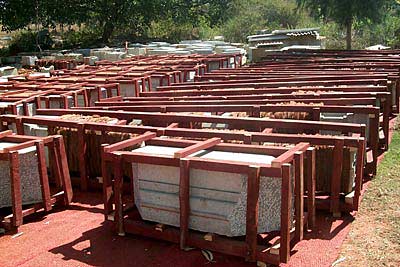
These are roof, pillar spanning beams, crated in Bangalore and ready to come to Kauai.
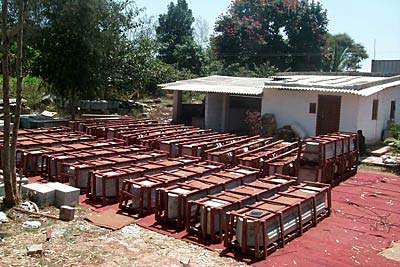
Each of these spanner beams has a 45 degree pointed end.
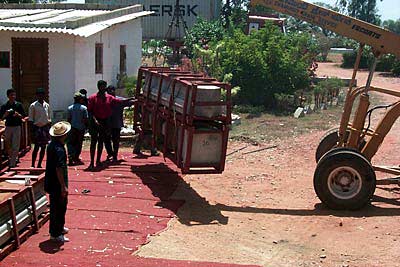
The ends of four such beams will meet on top of a Pothigai which rest on top of a pillar. Here is one beam and one pillar ready for loading.
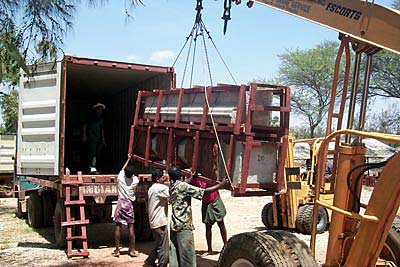
The beams will thus form open squares of the ceiling.
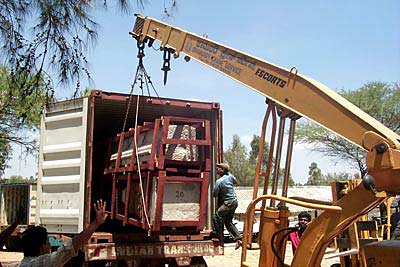
In you go!
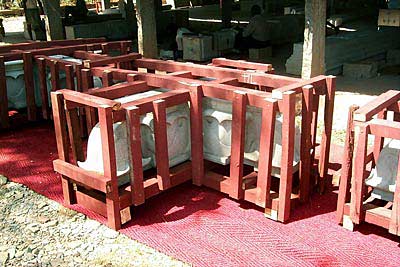
This is a good shot of a Pothigai stone. Four beams will rest on top of the four "wings" of each Pothigai.
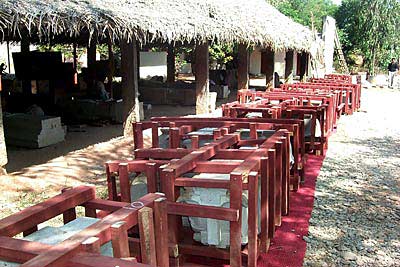
Lined up ready to go.
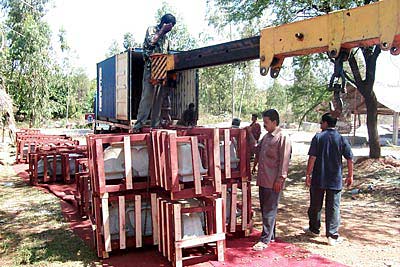
Two up for the container.
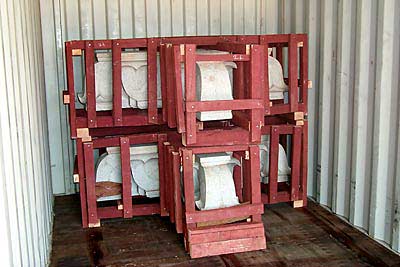
Ready for Hawaii!
| FULL INDEX OF 650+ CYBERTALKS
 |
|
Study Gurudeva's teachings.
|
transcription begins
Date: October_10_2002
Title: Bodhinatha's Travels to Mauritius Part 3
Category: Travels, Pilgrimage and Missions Abroad
Duration: 10 min., 3 seconds
Date Given: October 01, 2002
Given by: Bodhinatha
Then we flew back to Malaysia. We had a book-signing at the Kandaswami Temple. The Ceylon Saivite Association of Selangor, who some 20 years ago had hosted the famous, 'Two schools of Saiva Siddhanta Conference'. But, these days we are on the best of terms. The President was extremely respectful, Mr. Perambalam. The youth of the Temple and our own youth worked hard to coordinate the event. Gurudeva, on his last visit, went to the Temple. Times have changed, we are on the same side. That's nice.
You probably saw the pictures. That was the world's largest garlands there! I left them on. I was in a chair with a back and although I was like, "Unhh...", under a huge weight of garlands, they were so beautiful, didn't want to take them off. They came down to the ground and just weighed a lot. That was the talk on 'Naalupada Saivam', the 4 stages of discipline in Saiva siddhanta that you must have heard, drawing heavily from 'Dancing with Siva'. Sold lots of books, including 23 of 'Living with Siva', which was very good, an expensive book for Malaysia and the talk was well received.
We had a nice meeting with the youth group in Malaysia. Malaysia Youth Group is anyone under 30. A different concept of youth than here in the US, where youth is anyone under 20. The Youth Group is coming together in a dynamic way and had two 'Master Course Seminars', had the Family Retreat and honoring of mothers and fathers on Mother's Day and Fathers's Day. A lot of activity recently. They are planning an Iraivan Day for January, and lots of other wonderful activities. A very organised group and dynamic. The Kulapatis are happy to step back a bot and let the younger group create activities and are happy to supervise. They are coming together with a new energy, which is nice to see.
Then in Singapore, we pulled out our 'Nine Qualities' again and gave a talk at the Hindu Center, filled up the room, which was about 200 people. That was just in English, got the ideas out. Rajadurai was there, an elder in the community, comes for everything. This is the first time I have given a talk in Singapore. Usually, I have just spoken to the Members and this was reaching out beyond our own group there.
Just a thought here on one of the 'Nine Qualities'. Perceptive Self-Correction, the ability to quickly draw the lesson from each experience. and resolve how not to repeat one's mistakes. This quality is developed by teaching that mistakes are not bad, they are opportunities to learn and refine our behavior. Gurudeva calls them 'wonderful'. In 'Living with Siva', he says, "wonderful opportunities to learn."
On a number of occasions, I took a poll. I said, "Now, how many of you were raised to look at mistakes as wonderful opportunities to learn? Please raise your hand." I think I got 2 hands, out of the hundreds of people. It is not a common perspective. Somehow, the usual teaching is mistakes are bad, you are supposed to be smart enough not to make mistakes. Somehow, you are supposed to know so many things and never make a mistake. If you make a mistake, it reflects badly on the family and so forth, it is terrible.
That is not being realistic. The process of mistakes, that Gurudeva points out so wisely, from an up-down point of view, they are wonderful oppurtunitites to learn and that is how we improve. By making mistakes.
I told another story. I said, "Imagine this situation. A mother is at home with a young child. The child makes a huge mistake at 2, 3 o'clock in the afternoon. What does the mother do? The mother calls up the father at work.
"Dear, I have wonderful news for you. Our young boy made this horrendous mistake and we have a wonderful opportunity to teach a very good lesson here, so he doesn't do it again. I wanted to call you up, so that on your way home from work, you could start thinking about it and by the time you got here, you can figure out what lesson it is you need to teach the boy, so he doesn't do this again. Isn't this wonderful?"
Try and get a new perspective on it. Gurudeva definitely had that perspective, that mistakes are wonderful opportunities to learn. It is related to 'Positive Discipline'. Not the same subject, but looking at it from the teaching point of view, that is an obligation in any situation, a parent-child situation, to teach and to learn. When mistakes occur, it is the duty of the parents to teach something and the duty of the child to try and learn, so the child does not repeat the mistake again. Definitely, it is the whole negativity surrounding mistakes that makes this process difficult. Sweep that all away and take a fresh look at mistakes. "How wonderful! I made a mistake. I have a chance to teach something."
That is how progress occurs, right? If we never make a mistake, we are never progressing. We make mistakes, because we are trying to do new things that we have not done before. We are growing up and we don't know certain things. Mistakes are a natural part of human development. The whole idea about making them good is the first idea, erasing the sense of negativity. It applies in any teaching situation -parents to children, senior monks to junior monks, Talaivar to members of the Kulam, schoolteacher to children, supervisor to employee. All kinds of situations have this process involved and in each case, the senior one should expect mistakes and when they do occur, not put out a sense of something wrong or bad. Instead, try to figure out what it is that the person needs to learn, to not repeat the mistake.
Quite often with parents and children, the parents are assuming the child knows something he doesn't fully understand. They have taught it, either not at all or they have taught it incompletely or they have rushed through the lesson. The child doesn't really understand something that they think he does. Therefore, the mistake occurred. Having enough patience to ferret out what it is, what understanding is missing, is an important part. When all of that has taken place, then you get the quality we want in someone, Perceptive Self-Correction. As an adult, you develop a habit of correcting your own mistakes, because of how you were raised. When they make a mistake, they don't get depressed. They think about it. "What did I do wrong? How can I do it differently the next time and not have the same problem occur?" Just a way of thinking about life.
transcription ends
|
MORE UPLIFTING THINGS |
Innersearch 2003-4 in India!
We just completed the July 17-23 Kauai Innersearch, 2002. Bodhinatha will lead the next Innersearch to India, between Dec 2003 and Jan 2004. We will visit Bangalore and the Iraivan Carving Village, and settle in the South in Tamil Nadu, Click on the above for details on what will be an inspiring journey to our holy land of Bharat! |
|

|
Check our children and youth section for new items for the young and young at heart! | |
|
1. SIGN OUR GUESTBOOK and receive a FREE GIFT |
||
| 2. Newest Book: LIVING WITH SIVA | ||
|
3. Visiting KAUAI'S HINDU MONASTERY |
||
|
4. Contribute to THANK YOU, GURUDEVA FUND |
||